初中新目标英语全英说课稿模板
初中英语全英说课稿优秀8篇
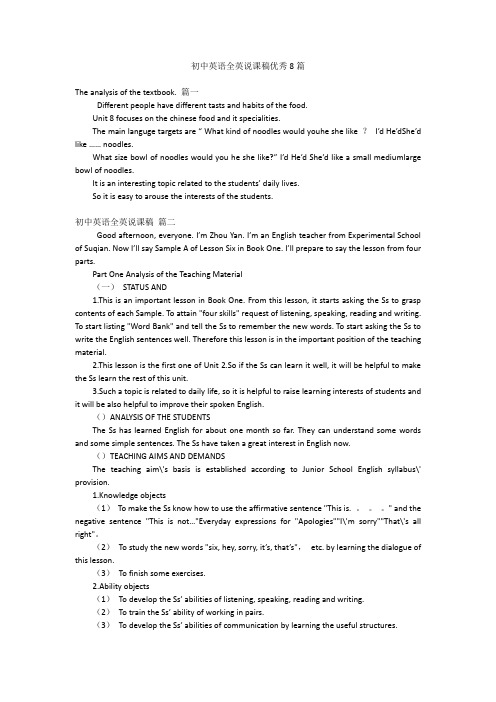
初中英语全英说课稿优秀8篇The analysis of the textbook. 篇一Different people have different tasts and habits of the food.Unit 8 focuses on the chinese food and it specialities.The main languge targets are “ What kind of noodles would youhe she like ?I’d He’dShe’d like …… noodles.What size bowl of noodles would you he she like?” I’d He’d She’d like a small mediumlarge bowl of noodles.It is an interesting topic related to the students’ daily lives.So it is easy to arouse the interests of the students.初中英语全英说课稿篇二Good afternoon, everyone. I’m Zhou Yan. I’m an English teacher from Experimental School of Suqian. Now I’ll say Sample A of Lesson Six in Book One. I’ll prepare to say the lesson from four parts.Part One Analysis of the Teaching Material(一)STATUS AND1.This is an important lesson in Book One. From this lesson, it starts asking the Ss to grasp contents of each Sample. To attain "four skills" request of listening, speaking, reading and writing. To start listing "Word Bank" and tell the Ss to remember the new words. To start asking the Ss to write the English sentences well. Therefore this lesson is in the important position of the teaching material.2.This lesson is the first one of Unit 2.So if the Ss can learn it well, it will be helpful to make the Ss learn the rest of this unit.3.Such a topic is related to daily life, so it is helpful to raise learning interests of students and it will be also helpful to improve their spoken English.()ANALYSIS OF THE STUDENTSThe Ss has learned English for about one month so far. They can understand some words and some simple sentences. The Ss have taken a great interest in English now.()TEACHING AIMS AND DEMANDSThe teaching aim\'s basis is established according to Junior School English syllabus\' provision.1.Knowledge objects(1)To make the Ss know how to use the affirmative sentence "This is. 。
初中英语说课稿模板5篇

初中英语说课稿模板5篇初中英语说课稿模板(精选篇1)今天我说课的内容是《牛津初中英语》8A Unit 2 School Life的Reading第一课时。
对于这节课我将以教什么、怎么教、为什么这么教为思路,从教材分析、教法分析、学法分析和教学过程四个方面加以说明。
一、说教材本课以school lives为话题,以学习life in a British school and in an American school 为载体,以find out the differences between a British school and an American school 为任务。
为了使学生对这一话题更感兴趣,在教学过程中,我准备采用多媒体辅助教学这一教学模式设置情境,有效地将单词、句子和情景相结合,达到语言点的灵活运用和学生学以致用的目的。
教学目标:能听懂,会说,会读,会拼写单词mixed,subject,sew,tasty,hero,close,taste and article。
能根据关键词和上下语境猜测课文大意。
重难点:本课是Reading的第一课时,主要为了完成这样一个任务,即通过阅读理解文章主题,通过设计一些如true or false questions,answer questions,fill in the blanks,line the words等练习题检查学生对课文的理解程度。
由于新课程标准要求大力培养学生的阅读能力,所以通过阅读理解文章大意就成了本课的重点。
通过对文章的理解要求学生能用自己的语言描述出相关内容,这就是本课的难点。
二、说教法1.直观情境教学法:本课将利用多媒体创设情境,激发学生的好奇心和求知欲;设置语境,使学生体验语言的真实、自然,从而培养学生组织和表达语言的能力。
2.任务型教学法:根据任务型教学的原则设计语言实践活动,通过学生体验、参与、合作、交流、探究等方式学习和使用英语,从而完成教学任务。
初中英语说课稿范文模板7篇
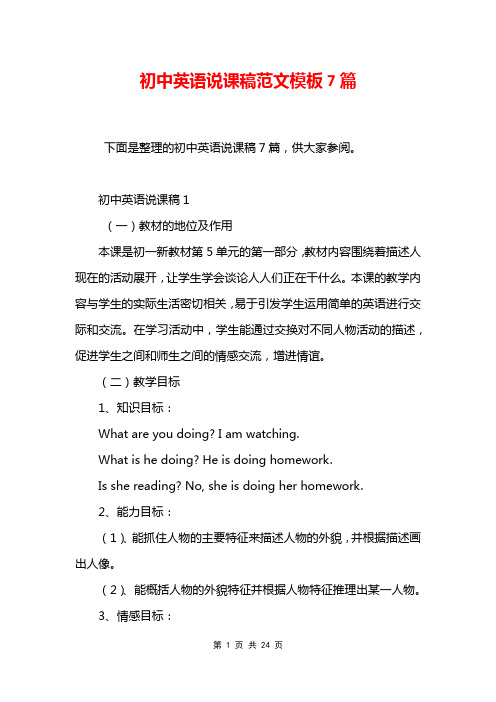
初中英语说课稿范文模板7篇下面是整理的初中英语说课稿7篇,供大家参阅。
初中英语说课稿1(一)教材的地位及作用本课是初一新教材第5单元的第一部分,教材内容围绕着描述人现在的活动展开,让学生学会谈论人人们正在干什么。
本课的教学内容与学生的实际生活密切相关,易于引发学生运用简单的英语进行交际和交流。
在学习活动中,学生能通过交换对不同人物活动的描述,促进学生之间和师生之间的情感交流,增进情谊。
(二)教学目标1、知识目标:What are you doing? I am watching.What is he doing? He is doing homework.Is she reading? No, she is doing her homework.2、能力目标:(1)、能抓住人物的主要特征来描述人物的外貌,并根据描述画出人像。
(2)、能概括人物的外貌特征并根据人物特征推理出某一人物。
3、情感目标:通过描述同学、教师或自己的偶像的外貌,表达自己的看法,使学生在人际交往中学会尊重和理解别人,学会交换不同的看法,了解他人的爱好,增进情谊。
(三)教学重点及难点1、掌握并运用描述人物活动和地点的词汇:watching, doing, eating cleaning, playing, reading, swimming, shopping, pool, school, mall, library2、掌握并运用简单的英语交际句型:What are you doing? I am watching.What is he doing? He is doing homework.Is she reading? No, she is doing her homework.(四)。
教法设计对本课我主要采取了如下几种教法:1.听录音。
听音是英语学习的重要方法,也是课堂教学的重要步骤。
在听中可以感知,可以模仿。
2.重点解释,个别操练。
初中英语全英说课稿优秀9篇
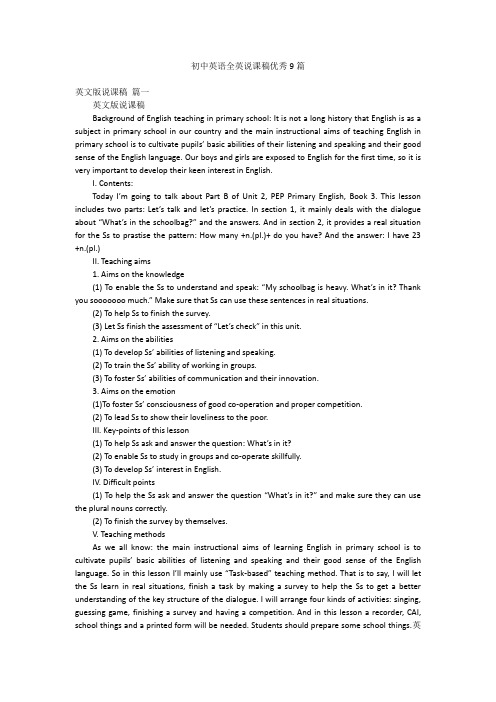
初中英语全英说课稿优秀9篇英文版说课稿篇一英文版说课稿Background of English teaching in primary school: It is not a long history that English is as a subject in primary school in our country and the main instructional aims of teaching English in primary school is to cultivate pupils’ basic abilities of their listening and speaking and their good sense of the English language. Our boys and girls are exposed to English for the first time, so it is very important to develop their keen interest in English.I. Contents:Today I’m going to talk about Part B of Unit 2, PEP Primary English, Book 3. This lesson includes two parts: Let’s talk and let’s practice. In section 1, it mainly deals with the dialogue about “What’s in the schoolbag?” and the answers. And in section 2, it provides a real situation for the Ss to prastise the pattern: How many +n.(pl.)+ do you have? And the answer: I have 23 +n.(pl.)II. Teaching aims1. Aims on the knowledge(1) To enable the Ss to understand and speak: “My schoolbag is heavy. What’s in it? Thank you sooooooo much.” Make sure that Ss can use these sentences in real situations.(2) To help Ss to finish the survey.(3) Let Ss finish the assessment of “Let’s check” in this unit.2. Aims on the abilities(1) To develop Ss’ abilities of listening and speaking.(2) To train the Ss’ ability of working in groups.(3) To foster Ss’ abilities of communication and their innovation.3. Aims on the emotion(1)To foster Ss’ consciousness of good co-operation and proper competition.(2) To lead Ss to show their loveliness to the poor.III. Key-points of this lesson(1) To help Ss ask and answer the question: What’s in it?(2) To enable Ss to study in groups and co-operate skillfully.(3) To develop Ss’ interest in English.IV. Difficult points(1) To help the Ss ask and answer the question “What’s in it?” and make sure they can use the plural nouns correctly.(2) To finish the survey by themselves.V. Teaching methodsAs we all know: the main instructional aims of learning English in primary school is to cultivate pupils’ basic abilities of listening and speaking and their good sense of the English language. So in this lesson I’ll mainly use “Task-based” teaching method. That is to say, I will let the Ss learn in real situations, finish a task by making a survey to help the Ss to get a better understanding of the key structure of the dialogue. I will arrange four kinds of activities: singing, guessing game, finishing a survey and having a competition. And in this lesson a recorder, CAI, school things and a printed form will be needed. Students should prepare some school things.英文版英语说课稿VI. Teaching procedures and purposes of my designing.I’ll finish this lesson in five steps.Step 1. Warm-up and preview1. Free talk between T and Ss about things in the classroom.2. Sing the song together: Books and pencils.3. Do some TPR, for example: Show me your English book. Show me your crayon.4. Review the numbers by asking: “How many crayons do you have?”Purpose: It is important to form a better English learning surrounding for the Ss by singing and doing some total physical response and at the same time it provides situations to review learned knowledge for the next step.Step 2. PresentationNow I’ll mainly talk about this step.1. Present the pattern: “My schoolbag is heavy.” “What’s in it?.”(1) Show a bag and say: “Look! I have a bag.” Carry it and say: “Oh, it is heavy. My schoolbag is heavy.” Help the Ss understand the meaning with the help of my body language. Then lead the Ss to read the sentence. Make sure they can say it correctly.(2) T: My schoolbag is heavy.Open the bag and say: “What’s in it? What’s in my schoolbag?”Take out a Chinese book. Then do the action again. Let the Ss read the sentence.2. Play a guessing game. Divide the whole class into four groups to have a competition.Let them guess: What’s in the bag? How many? Purpose: To present the key structures one by one is much easier for the Ss to learn and grasp the meanings. Proper competition can arouse the Ss’ interest in English learning.3. With the help of the CAI to present the dialogue. Set a situation to help Ss understand: Two Ss are coming. One girl is carrying a heavy bag on her back. They are talking.Girl: My schoolbag is heavy.Boy: What’s in it?Girl: 20 story-books, 32 pencil, 9 rulers, 12 crayons and 30 picture-books. Etc.Boy: What will you do?Girl: They are for the poor.Boy: Great! I’ll bring some school things too.The boy comes back home and puts a lot of things into the bag. Then he goes to school again and gives them to a teacher. While he is taking them out, he is counting the numbers of all things. The teacher says: Thank you soooooooo much.4. Mention that we should take care of the poor.5. Play the cassette. Let the Ss listen and imitate the dialogue.Pay attention to their pronunciation and intonation. Purpose: CAI can provide a real situation for the Ss to understand the dialogue and the relationships between people better. Tell the Ss we should show our loveliness to the Ss.Step 3. PracticeDivide Ss into groups of six children. Each one would finish the printed form by asking and answering: How many storybooks do you have? Find out which group finishes faster. Story books picture-books sharpeners crayons pencils erasers pencil-cases rulers Chen Jie 8 24 3 32 26 4 1 3Purpose: Task-based teaching method is used here to develop Ss’ ability of communication and also their ability of co-operation will be well trained.Step 4. AssessmentHelp Ss finish “Let’s check” of this unit and workbook.Purpose: To check the knowledge Ss have learned in this period.Step 5. Add-activity1. Let Ss tell each other how many school things they have after class. Tell their parents how many school things they have at home.2. Take care of everything they have.Purpose: Revision is so important that Ss should speak English as much as they as in class or after class. It is necessary for the Ss to do some extensive exercises after class to consolidate the knowledge they learned.英文版英语说课稿初中英语说课稿篇二今天我的说课内容是新目标英语八年级上册第四单元第一课时。
新目标初三英语全英文说课稿[精选5篇]
![新目标初三英语全英文说课稿[精选5篇]](https://img.taocdn.com/s3/m/e6f6376a302b3169a45177232f60ddccda38e604.png)
新目标初三英语全英文说课稿[精选5篇]第一篇:新目标初三英语全英文说课稿新目标初三英语全英文说课稿初三英语 Unit 4 What would you do 说课稿T:Good afternoon,everyone.I'm glad to have an apportunity to talk about some of my teaching ideas.My topic is talking about imaginary situations from Go for it Section A , Unit 4 , Book 3.I'll talk about the following parts.First, I'll talk about my understanding of this teaching material.In this unit student s learn to talk about imaginary situations.Such topic enables students to activate their imagination and raise learning interest of students.Most of students are active in such activities.I'll talk about the first period of Unit 4.The first period introduces the key vocabulary words and the target language in this unit.The topic,what would you do if you had a lot of money makes the introduction easier.I.Teaching aims of this lesson.1.Knowledge objects: Students will be able to understand the grammar of subjunctive mood, some important phrases and sentences.2.Ability objects: To train students' listening and speaking skills.3.Moral objects : Remember it's really being cool to realize your dream through great efforts.II.Key points and difficult points.1.Key vocabulary : million, medical , research, tie, what if 2.Target language: What would you do if you had.3.The structure : I would / I'd do.III.Something about the students 1.Most of them don't often use English to express themselves and communicate with others.2.Some of them aren't active in class because they are afraid of making mistakes.IV.Now next ,I'll talk about my teaching opinions, methods and aids.While dealing with the lesson , I'll do my best to carry out the following teachingbine the language structures with the language functions.2.Let students know how to talk about imaginary situations with the subjunctive mood 3.I'll take the T ask-based learning approach.4.And I'll use some teaching aids, such as a tape recorder, CAI and so on.V.Now let me talk about my teaching procedures.Step 1: Lead-in T: What a fine day, isn't it If it's fine this Sunday, what will you do S1: I will go shopping with my friends if it is fine this Sunday.S2: I will go to the park with my cousin.T: Then if there were no classes this afternoon,what would you do Tell students that there are classes this afternoon in fact.Let Ss know why we use “were” and “would”.Help Ss answer with “I would doif there were no classes this afternoon”.S3: I would play basketball with my friends if there were no classes this afternoon.T: After school Jim played basketball with his friends.He went back home very late and his mother was very angry.If you were him, what would you do Can you give him some advice S4: If I were him , I would say sorry to mother.S5: If I were him, I would try to do something to make mother happy.T: There will be an English test.Jim worries about it.What should he do S6;If I were him , I would study harder.In this step,I want to revise the if clause,and next I will lead in the subjunctive mood.I think students can understand easily and grasp it.Step 2: Practice T;Bill Gates is a very rich man in the world.He has given a lot of his money to charity.If you had so much money, what would you do Get Ss to think it over and write down their answers(Section A 1a)Let Ss listen to the tape and number the picture.(Section A 1b)Then get Ss to practice the conversation.Ss practice the conversation, they communicate with each other often.Everyone has a chance to speak English.Step3: Listening and practicing T:If I had much money, I'dbuy many presents for each of my rry is going to his friend,Tom's birthday party.But he's a little nervous.Why Can you guess S1: Perhaps he is late.S2: He doesn't have enough money to buy a present … T;Maybe you are right.I'm not sure.Let's listen to the tape.Get Ss to listen to the tape and circle the reasons(Section A 2a)Get Ss to listen to the tape again and check the advice Larry's sister says to him.Let Ss read the conversation after the tape.Then let Ss do pairwork.S1: Hi, Harry.You look worried.S2;I'm going to Tom's party.But I don't know what to wear.S1: If I were you, I would wear a shirt and a tie.S2;I don't have a present.What if everyone else brings a present ……After this step.Ss can have a good understanding of the subjunctive mood and develop their listening ability Step 4: Discussion Get Ss to choose one of the following situations or make up another imaginary situation , have a discussion in groups and write down their advice,then give a report.1.T om had an argument with his best friend.What should he do 2.There are always some Ss talking in class.If you were the teacher,what would you do In this step, students can use English in the real situation and use English to solve the real problems.Step 5: Homework Writ e a passage “If I were a teacher/headmaster” At last ,let me talk about my blackboard design.We will have a look at it on the blackboard.Unit 4 What would you do Words and phrases Sentences Million What would you do if you had a million dollars Medical research I'd give it to charity.What if If I were you , I'd wear a shirt and a tie Worry about Tie I write these words and phrases on the blackboard in order to tell the students that they are very important.I think my blackboard design will help students understand the lesson better.So much for this.Thank you.第二篇:人教版新目标九年级英语全英文说课稿找教案Unit13Rainy days make sad.SectionA(1a-1c)Hello, everyone,Today I’m very pleased to have an opportunity to talk about some of my teaching ideas.My topic is Section A(1a-1c , Grammar Focus)in Unit13.It is made up of seven parts.1.Analysis textbook(教材分析)2.The teaching methods(教学方法)3.The learning methods(说学法)4.Analysis the students(说学情)5.The procedures of the teaching(教学步骤)6.Blackboard design(板书设计)7.Self evaluation.(自评)Part 1The analysis of the teaching material:This lesson is about listening and speaking.It plays a very important part in the English teaching of this unit.By studying Section A , The students can improve their speaking ability, learn more about things that affect people.At the same time, we should get the students to understand better.The students should do some listening, speaking and writing, too.Of course, the students should receive some moral education.Let the students have positive attitude to dealing with things around them.1.Teaching objectsThe teaching aims are established according to Junior School English curriculum standard nguage goals1).Words & expressions :tense, some adjectives of feeling2).Key sentencesLoud music makes me tense.(P103)Loud music makes me want to dance.That movie made me sad.B.Ability goalsEnable the students to talk about how things affect them.Emotion & attitude goalsEnable the students to understand the effect of things upon them.The teaching key and difficult points are established according to Section A ,Unit13 in the teaching material’s position and function.2.Teaching Key Pointsthe usage of make.3.Teaching DifficultiesTrain the Ss to use make correctly.T o improve students’ listening ability.To train students' communicative competence.:Part 2.The teachingmethodsTask-based teaching;Cooperative learning;Part 3.The learning methods1).Set up six steps.It is presentation–words –pairwork –listening practice–Grammar-practice2).Ask the students to take part in class actively and develop their cooperation in the activities.Part 4.Analysis the students The students have learned some words about feeling and they have know the word make.But they don’t often use English to express themselves and communicate with others.Some Ss are not active in the class because they are afraid of making mistakes.Part 5.The procedures of the teachingI have designed the following steps to train their ability of listening, speaking, reading and writing, writing , especially listening and speaking.Set up six steps.It is greeting –lead-in-presentation– words – pairwork – listening practice–Grammar –practice –homework.Step Ⅰ Lead-in.Show the Ss a picture and then show the teaching material.Purpose: Arouse the students’ interest of study.Bring in new subject: Rainy days make me sad.Step IIPresentation.Review some words about feeling , then present the sentence structure.A:What makes him/her B:makeshim sad.Purpose :Through this part we can consolidate what they studied yesterday, communicate with others about their feelings and prepare for the new lesson.Step IIIListening(1a, 1b: P102) Ask the students to listen to Amy and Tina talking about the two restaurants and do the exercises.Purpose :Train the Ss’ listening ability and prepare for later exercises.Step IVSpeaking(1c: P102)Ask the students to talk about how music affects them.Let the Ss work in pairs andtalk about how the two restaurants would affect them.Purpose :Train the Ss’ speaking ability and prepare for later exercises.Step VDo a survey.After learning 1b , 1c , let the Ss do a survey about other things that affect them.Purpose : This step can open the Ss eyesight and thought.It’s a step from textbook to real life.Step VIGrammar1).Sum the usage of make then help them to say out the sentence structure.2).Do some exercises to consolidate the grammar.Purpose: Train the Ss’ ability of understanding and using language.Step VIIWriting practice1.List 4-5 things around you and then describe how the things affect you.positionExams make me _______。
初中英语说课稿(集锦15篇)
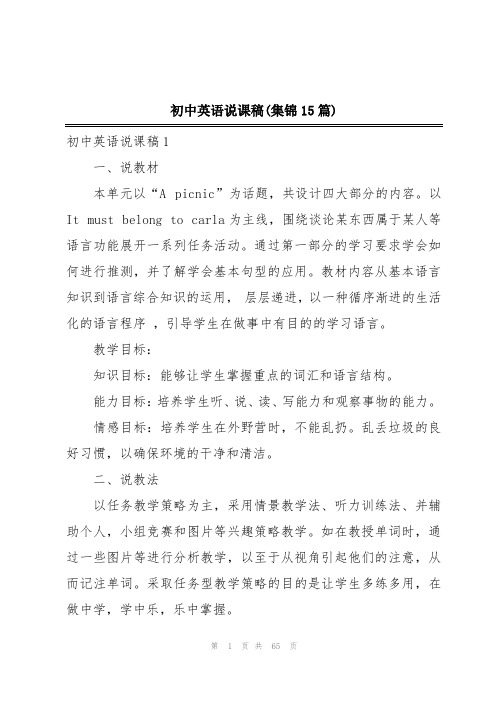
初中英语说课稿(集锦15篇)初中英语说课稿1一、说教材本单元以“A picnic”为话题,共设计四大部分的内容。
以It must belong to carla为主线,围绕谈论某东西属于某人等语言功能展开一系列任务活动。
通过第一部分的学习要求学会如何进行推测,并了解学会基本句型的应用。
教材内容从基本语言知识到语言综合知识的运用,层层递进,以一种循序渐进的生活化的语言程序,引导学生在做事中有目的的学习语言。
教学目标:知识目标:能够让学生掌握重点的词汇和语言结构。
能力目标:培养学生听、说、读、写能力和观察事物的能力。
情感目标:培养学生在外野营时,不能乱扔。
乱丢垃圾的良好习惯,以确保环境的干净和清洁。
二、说教法以任务教学策略为主,采用情景教学法、听力训练法、并辅助个人,小组竞赛和图片等兴趣策略教学。
如在教授单词时,通过一些图片等进行分析教学,以至于从视角引起他们的注意,从而记注单词。
采取任务型教学策略的目的是让学生多练多用,在做中学,学中乐,乐中掌握。
三、说学法采用合作式学习方式,有目的的让学生预习,在完成任务的活动中主动的学习语言。
养成继续学习英语、学好英语的良好习惯。
并让学生学会如何推测,以至于在做推测性的阅读题时有很好的方法。
强调学生不仅在课上积极发言、多练,并鼓励他们课后成立英语学习兴趣小组、英语角等,积极参加训练。
四、说教学过程1、课前任务设置。
在每一节课,我让学生提前预习,课前三分钟,我让学生学唱“Are you sleeping ”的歌曲。
目的是激发他们的学习热情。
另一方面,铃声响的时候,首先检查学生对第四单元的识记情况。
然后让学生看屏幕,用“Who is he ?” 句子问,用“It can?t、may 、must be ”等回答,之后通过“Look and learn”推出新单词“belong、belong to” 和教授的单元。
在此期间,让学生感知的重点句型结构。
把单词的教学融入句型,培养学生情景中理解单词的能力。
初中英语全英说课稿(优秀5篇)
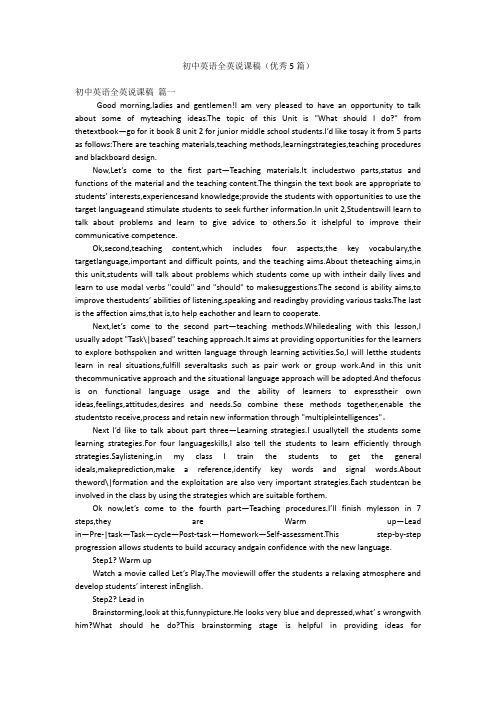
初中英语全英说课稿(优秀5篇)初中英语全英说课稿篇一Good morning,ladies and gentlemen!I am very pleased to have an opportunity to talk about some of myteaching ideas.The topic of this Unit is "What should I do?" from thetextbook—go for it book 8 unit 2 for junior middle school students.I’d like tosay it from 5 parts as follows:There are teaching materials,teaching methods,learningstrategies,teaching procedures and blackboard design.Now,Let’s come to the first part—Teaching materials.It includestwo parts,status and functions of the material and the teaching content.The thingsin the text book are appropriate to students’ interests,experiencesand knowledge;provide the students with opportunities to use the target languageand stimulate students to seek further information.In unit 2,Studentswill learn to talk about problems and learn to give advice to others.So it ishelpful to improve their communicative competence.Ok,second,teaching content,which includes four aspects,the key vocabulary,the targetlanguage,important and difficult points, and the teaching aims.About theteaching aims,in this unit,students will talk about problems which students come up with intheir daily lives and learn to use modal verbs "could" and "should" to makesuggestions.The second is ability aims,to improve thestudents’ abilities of listening,speaking and readingby providing various tasks.The last is the affection aims,that is,to help eachother and learn to cooperate.Next,let’s come to the second part—teaching methods.Whiledealing with this lesson,I usually adopt "Task\|based" teaching approach.It aims at providing opportunities for the learners to explore bothspoken and written language through learning activities.So,I will letthe students learn in real situations,fulfill severaltasks such as pair work or group work.And in this unit thecommunicative approach and the situational language approach will be adopted.And thefocus is on functional language usage and the ability of learners to expresstheir own ideas,feelings,attitudes,desires and needs.So combine these methods together,enable the studentsto receive,process and retain new information through "multipleintelligences"。
初中英文说课稿
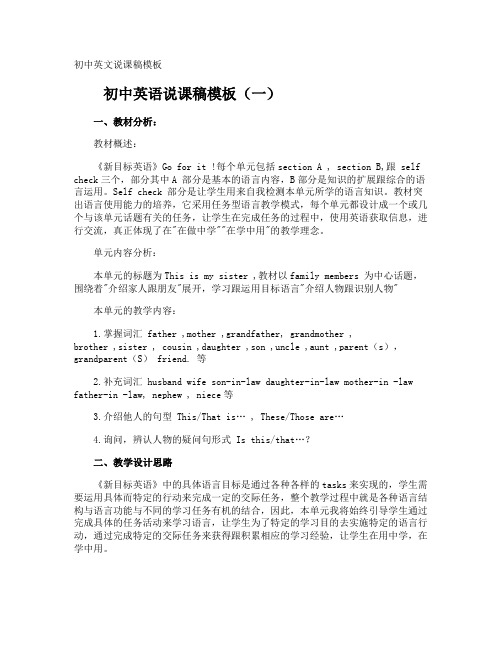
初中英文说课稿模板初中英语说课稿模板(一)一、教材分析:教材概述:《新目标英语》Go for it !每个单元包括section A , section B,跟 self check三个,部分其中A 部分是基本的语言内容,B部分是知识的扩展跟综合的语言运用。
Self check 部分是让学生用来自我检测本单元所学的语言知识。
教材突出语言使用能力的培养,它采用任务型语言教学模式,每个单元都设计成一个或几个与该单元话题有关的任务,让学生在完成任务的过程中,使用英语获取信息,进行交流,真正体现了在"在做中学""在学中用"的教学理念。
单元内容分析:本单元的标题为This is my sister ,教材以family members 为中心话题,围绕着"介绍家人跟朋友"展开,学习跟运用目标语言"介绍人物跟识别人物"本单元的教学内容:1.掌握词汇 father ,mother ,grandfather, grandmother ,brother ,sister , cousin ,daughter ,son ,uncle ,aunt ,parent(s),grandparent(S) friend. 等2.补充词汇 husband wife son-in-law daughter-in-law mother-in -law father-in -law, nephew , niece等3.介绍他人的句型This/That is… , These/Those are…4.询问,辨认人物的疑问句形式Is this/that…?二、教学设计思路《新目标英语》中的具体语言目标是通过各种各样的tasks来实现的,学生需要运用具体而特定的行动来完成一定的交际任务,整个教学过程中就是各种语言结构与语言功能与不同的学习任务有机的结合,因此,本单元我将始终引导学生通过完成具体的任务活动来学习语言,让学生为了特定的学习目的去实施特定的语言行动,通过完成特定的交际任务来获得跟积累相应的学习经验,让学生在用中学,在学中用。
新目标英语九年级全册纯英文说课稿
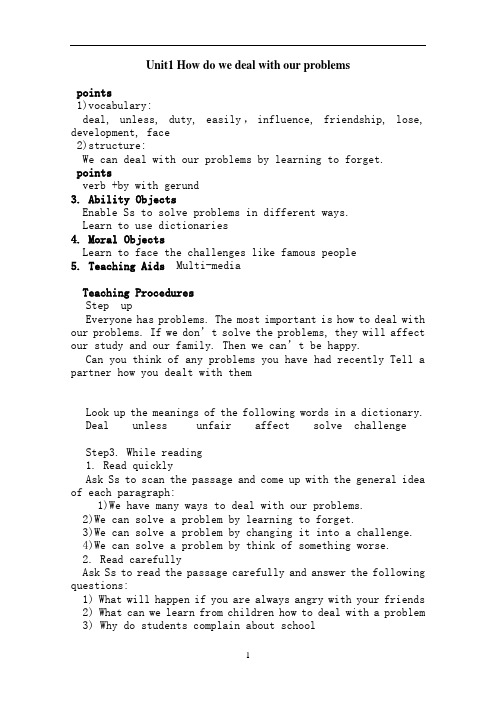
Unit1 How do we deal with our problemspoints1)vocabulary:deal, unless, duty, easily,influence, friendship, lose, development, face2)structure:We can deal with our problems by learning to forget.pointsverb +by with gerund3. Ability ObjectsEnable Ss to solve problems in different ways.Learn to use dictionaries4. Moral ObjectsLearn to face the challenges like famous people5. Teaching Aids Multi-mediaTeaching ProceduresStep upEveryone has problems. The most important is how to deal with our problems. If we don’t solve the problems, they will affect our study and our family. Then we can’t be happy.Can you think of any problems you have had recently Tell a partner how you dealt with themLook up the meanings of the following words in a dictionary.Deal unless unfair affect solve challengeStep3. While reading1. Read quicklyAsk Ss to scan the passage and come up with the general idea of each paragraph:1)We have many ways to deal with our problems.2)We can solve a problem by learning to forget.3)We can solve a problem by changing it into a challenge.4)We can solve a problem by think of something worse.2. Read carefullyAsk Ss to read the passage carefully and answer the following questions:1) What will happen if you are always angry with your friends2) What can we learn from children how to deal with a problem3) Why do students complain about school4) How can we find our problems are not terribleStep4. Post-reading,Get Ss to watch the video on Stephen Hawking and ask Ss what they can learn more from this clever scientist.Step5. DiscussionGet Ss to work in groups and discuss which way of dealing with problems is the best And then list more ways on the Bb.Step6. homeworkWrite about problems/ accidents when you dealt with before.Unit2 He used to cause a lot of troublepoints1)vocabulary:death, cause, himself, patient, make a decision, waste, take pride in, attention2)structure:He didn’t use to give his mother any problems.He has been working hard and is one of the best students.pointsbe used to do sthIt was exactly what I needed.It is very important for parents to be there for their children.3. Ability ObjectsEnable Ss to analyze their trouble and make a decision to change it.4. Moral ObjectsTo make a right decision to change problems.5. Teaching Aids Multi-mediaTeaching ProceduresStep up1)Everyone has problems. When I was young, I didn’t like school. After my mother told me the importance of study, I decided to study hard and make much progress and success.Tell your partner about a time your parents helped you with a problem.Step 2. Pre-readingGuess the meanings of the following words by using the context.death, cause, himself, patient, make a decision, waste,Step 3 While reading1.Read quickly1)Ask Ss to scan the passage and put these sentences into thecorrect places in the reading.2)Read the passage again and get the main idea of each paragraph:①Martin used to be a “problem boy after his father’s death.②His mother was very patient and tried to help him.③Martin started to change after the phone call④Now Martin has really changed.2. Read carefullyRead the statements and decide “true”, “false”or “d on’t know”.1)Martin’s father didn’t use to help him. D2)artin didn’t like the boarding school. T3)What his mother said changed Martin’s mind. T4)Martin feels good himself now. TStep4. Post-readingGet Ss to read again and retell the passage with the following sentences:1)Before his father’s death …2)After his father’s death …3)Now …Step5. DiscussionWork in groups and tell others the problems you are facing and ask them for advice on how to deal with them.Step 6. HomeworkMake the conversation between Martin and his mother on the phone.Unit3 Should I be allowed to make my own decisionpoints1)vocabulary:in the way, achieve, race, taught, importance, succeed, care about2)structure:I think I should be allowed to make my decisions for myself. Being a professional is the only thing I have ever wanted to do.pointspassive voice with modal verb should3. Ability ObjectsEnable Ss to analyze reasonable advice.4. Moral ObjectsLearn to analyze and take some reasonable advice.5. Teaching Aids Multi-mediaTeaching ProceduresStep upIn your group, discuss the following the questions.How old is a teenagerWhat are some of the rules that a teenager should obeyStep2. Pre-readingLook at the title of the reading. Answer Yes/No. Find out how many in your group agree with you.Step3. While reading1. Read quicklyAsk Ss to scan the passage and answer the following question: Why don’t Liu Yu’s parents let him practice running too much2. Read carefullyRead the statements and circle “true”, “false”or “d on’tknow”.1) Liu Yu’s parents are against running. F2) Liu Yu is unhappy that his parents won’t let him practice running. T3) Liu Yu thinks he will succeed in achieving his dream. T4) Liu Yu can win a gold medal in the marathon of Olympic Games. DStep4. Post-readingAsk Ss to make sentences with the following phrases:get in the way of… be serious about spend time on Step5. DiscussionGet Ss to discuss if Liu Yu should be allowed to practice running. Use the information in the reading to support your opinion.Step 6. HomeworkMake an article about a famous person. Write about his/herUnit4 What would you do if…points1)vocabulary:come out, cover, press, deep, downstairs, correct, burn, knee, pain, hurt, offer, refuse2)structure:If I were you, I’d talk to your friend about the danger s of smoking.pointsthe subjunctive mood3. Ability ObjectsEnable Ss to deal with problems using what they know.4. Moral ObjectsEnable Ss to think of ways to deal with problems and protect themselves.5. Teaching Aids Multi-mediaTeaching ProceduresStep upLet Ss watch the video “Jerry and Tom”and answer the following questions:1)How many problems and accidents did Jerry have2)If you were Jerry, what would you doreadingDiscuss the following questions and take notes.1)What kind of accidents do you know of2)What is the biggest problem a teenager hasTeach the new words: first-aid come out…Step3. While readingIf you couldn’t deal with the problems, what should you do Help Ss to answer: I could have a first-aid book in my home.1. Read quicklyAsk Ss to scan the passage and discuss the following questions:1)Why is cold water helpful to treat a small burn2)Why would it be dangerous to meet an “Internet friend”alone2. Read carefullyRead the statements and circle “true”, “false”or “d on’t know”.1) You can cover the cut with wet paper. F2) If someone fell down and couldn’t move, try to help it get up. F3)You can meet him /her anywhere because you are afraid of nothing. T4)We should refuse a cigarette at a party. T5)When you get pimples, you’d better have enough rest. Step4. Post-readingAsk Ss to find and study some new words and expressions through the context or by looking them up in a dictionary.Step5. DiscussionCan you think of more “accidents” and “problems” And what advice would you give to Dr Robinson’s book.Please work in groups and write down your ideas.Step 6. Summary and homeworkMake an article to give advice on “accidents” and “problems” you have ever had. Tell us what happened What did you do Did you ask for advice Did the advice helpUnit6 I only eat food that tastes good.points1)vocabulary:taste, mainly, stay away, actually, laboratory, itself, cancer, increase, risk, biscuit, main2)structure:I prefer not to eat too much food that is fried.The main thing is to have a good balance.pointsThe attributive clause with that and who.3. Ability ObjectsEnable Ss to express preferences.4. Moral ObjectsKeep healthy by eating a balanced diet.5. Teaching Aids Multi-mediaTeaching ProceduresStep upWhat food did you have for breakfast todayWhat food do you preferWhose breakfast is the healthiestGet Ss to discuss and give reasons.Step 2. Pre-readingAsk Ss to discuss the following questions:1)Are you a vegetarian2)Do you only eat food you likeStep 3. While readingA group of young people are discussing the same question. What are their opinions1. Read quicklyPlease read the passage quickly and find out who eats a balanced dietLaura eats a balanced diet and is a strict vegetarian.2. Read carefullyRead the statements and judge “true” or “false”.1) Peter only eats food that tastes good. T2) The burnt barbecued meat can increase the risk of cancer. T3)A vegetarian only likes vegetables. F4)Laura never eats meat. T5)Tony prefers to only food that he likes. TStep4. Post-reading1)Read the passage again and find out the thing that good for us and things that are bad for us.Step5. Do a class surveyGet Ss to work in pairs and find out partners’ diets and then make a short report. For esample:Jack is a strict vegetarian. He only likes fruits and vegetables. He never eats meat and never drinks Cola…Step 6. HomeworkWrite a passage about what we should eat or drink to keep healthy.Unit7 I’d like to sail across the Pacific.points1)vocabulary:sail, Pacific, findings, thousands of, as soon as possible, continue, programming, report, dream2)structure:Some students would like to work as soon as possible.pointsI’d like to…. I’d love to…. I hope….3. Ability ObjectsEnable Ss to talk about the hopes and dreams.4. Moral ObjectsHold on to your dreams.5. Teaching Aids Multi-mediaTeaching ProceduresStep upDo you have hopes and dreams, boys and girlsAsk Ss to write down their hopes and dreams, then ask some students to read them out.Step 2. Pre-readingAsk Ss to discuss the following questions and make a note. How can you achieve your dreamsStep3. While reading1. Read quicklyAsk Ss to scan the passage to get the structure of the passage as follows:1)What are the hopes of teenagers2)What are the dreams of teenagers3)Conclusion.2. Read carefullyRead the statements and circle “true” or “false”.1) All the teenagers would like to go to college after finishing education. F2) Some Ss would like to start work as soon as possible. T3) Some Ss hope to continue studying after finishing school. T4)Many students dream of becoming famous. F5) It’s important to hold on to your dreams to make them to come true. TStep4. Post-readingAsk Ss to read again and answer the question:What is important to students about the work they doStep5. DiscussionDiscuss the following question in small groups with reference to the reading.Is there anyone in the world who has no hopes or dreams Step 6. homeworkWrite down a dream you have and how you’ll achieve it.Unit8 I’ll send you a photo of lucky.points1)vocabulary:fill, organization, disabled, pleasure, blind, deaf, imagine, shut, carry, specially, fetch2)structure:An organization was set up to help disabled people.pointsPart of speech.3. Ability ObjectsEnable Ss to use parts of speech.4. Moral ObjectsLearn to offer help.5. Teaching Aids Multi-mediaTeaching ProceduresStep upAnimals are our friends. Have you got an animal petDo you like your itWhy do so many people keep animal pestWhat can animals do for peopleGet Ss to discuss and tell their opinions to the class. Step 2. Pre-readingToday, we’ll read a letter. There are many kinds of letters. Can you tell us how many kinds of letters you knowHow is a letter different from an articleGet Ss to discuss and list three defferences.Step3. While reading1. Read quicklyWell, read this letter quickly and tell what kind of letter it isAsk Ss to scan the passage to answer the question:It is a thank-you letter.2. Read carefullyRead the statements and circle “true” or “false”.1) “Animal Helpers” is set up to help poor people. F2)Disable people are blind and deaf. F3)Miss Li donated money to “Animal Helpers”. T4) Lucky can fetch things for disabled people. T5) Liz Smith bought Lucky from“Animal Helpers”. FStep4. Post-readingAsk Ss to find some new words and point out each one’s part of speech.Step5. DiscussionGet Ss to talk about what other animals can be trained to help people.Write it down and read it to the class.Step 6. Summary and homeworkWrite a short reply to Liz Smith. Offer to help her more. Saywhy and what you are able to help her.Unit9 Do you know when basketball was inventedpoints1)vocabulary:active, create, wooden, knock, divide, basket, metal, below, towards, develop, rise, risen2)structure:It’s played by millions of people.pointsPassive voice.3. Ability ObjectsEnable Ss to talk about the history of basketball.4. Moral ObjectsLearn sth from invention and get ready to serve the society.5. Teaching Aids Multi-mediaTeaching ProceduresStep upAre you interested in sports Can you say the names of sports in EnglishLet Ss have a memory challenge “How many sports can you say in English”Step 2. Pre-readingHow many different kinds of sports can you think of in China List 8 sports played in China. Rank them in the order of popularity.Step3. While reading1. Read quicklyAsk Ss to scan the passage to answer the question:What is the aim of basketballThe answer is for players to get the ball into the basket which has net hanging from a metal hoop.2. Read carefullyRead the statements and circle “true” or “false”.1)Basketball is very popular everywhere in China. T2)An American teacher invented basketball. F3)Players may use the backboard to guide the ball into the basket. T4)The first basketball game was played in 1936. F5) The number of foreign players in NBA has increased. T Step4. Post-readingAsk Ss to draw a mind-map with the information from the reading. Step5. DiscussionWould you like to play on China’s national basketball team on dayMake a list of good and difficult things about being a basketball player.Step6. Summary and homeworkWrite a passage about what you should do if you want to be an NBA player.Unit11 Could you please lend me your penpoints1)vocabulary:alright, direct, order, lend, lead, wonder, trouble, offend2)structure:I wonder if you can help me.pointsIndirect questions.3. Ability ObjectsEnable Ss to choose suitable language.4. Moral ObjectsLearn to use suitable language.5. Teaching Aids Multi-mediaTeaching ProceduresStep upDo you often have too much homeworkIf you need help with your homework, how would you ask these peopleYour parents:Your teachers:Your friends:Step 2. Pre-readingDiscuss the language you used to ask for help with your homework. Was it the same each time If not, discuss why notStep3. While reading1. Read quicklyAsk Ss to scan the passage and get the main idea of each paragraph.2. Read carefullyRead the statements and circle “true”or “false”.1) Knowing how to ask for information politely is important. T2) “Where are the restrooms” sounds more polite. F3)How to ask for information politely is not difficult. T2) You can ask your teacher like this, “ Where is my book”F3) The suitable language you need depends on your grammar. FStep4. Post-readingAsk Ss to role play the situations mentioned in the reading. Ask the other students to think about the relationships between the speakers and listeners.Step4. DiscussionNow, let’s have a discussion. Talk in groups and describe some suitable situations when you are in Shanghai World Expo. Step 5. Summary and homeworkMake up two conversations that happen in Shanghai World Expo.Unit12 You are supposed to write quickly.points1)vocabulary:rubbish, seek, chatline, online, type, form, symbol, beside, e-mail, fiddle, experiment, proper2)structure:E-mail English is supposed to be used on mobile phone.pointsPassive voice / be supposed to+ infinitive3. Ability ObjectsEnable Ss to use E-mail English.4. Moral ObjectsLearn to cooperate with others.5. Teaching Aids Multi-mediaTeaching ProceduresStep upLet Ss chantWhat are you supposed to do in ChinaWe’ re supposed to shake hands.Shake hands, shake hands.What are you supposed to do in JapanWe’ re supposed to bow backs.Bow backs, bow backs.Step2. Pre-readingAsk Ss if they can read the following expressions and how to write them in English.How RU CU! BTW CUL8rStep2. While reading1. Read quicklyAsk Ss to scan the passage and get the 2 kinds of email English Abbreviation and homophone.2. Read carefullyRead the statements and circle “true” or “false”.1) Many E-mail English words look like rubbish. T2) E-mail English is use to save time. T3) WBQ would mean with best questions. T4) E-mail English is supposed to be used in class. F5)Emoticons can be use to show your feelings. TStep4. Post-readingRead the passage again and answer the following questions:1)Why is email English being used nowadays2)How many forms are used to write email EnglishCan you give an example for each oneStep4. DiscussionGive Ss sentences, and get them to discuss in groups to write them in email English.Step 5. homeworkWrite a note to some friends using e-mail English.Unit13 Receiving money makes me uncomfortable.points1)vocabulary:purple, purse, guilty, tastes, saying, thought, count, art 2)structure:Receiving a purple purse makes me embarrassed.pointsMake sb + adjective. Make sb + infinitive.3. Ability ObjectsEnable Ss to talk about the feeling of receiving gifts.4. Moral ObjectsLearn to understand other people’s feeling.5. Teaching Aids Multi-mediaTeaching ProceduresStep 1. Warming upT: Hello, everyone. In this September, you will be high school students. It’s a big step in your lives. Would you like to get some gifts to celebrate itSs: Yes.T: What would you like to haveSs: I’d like to have a computer/ mobile phone.Get Ss to talk in pairs.Step 2. Pre-readingAsk Ss the following questions and get them to discuss in pairs. If you receive a gift from your best friend, how will you feel What do you think of receiving giftsStep3. While reading1. Read quicklyAsk Ss to scan the passage and answer the question:Why does receiving money make me feel uncomfortable2. Read carefullyRead the statements and circle “true” or “false”.1) Receiving money might make people feel embarressed. T2) Guo Xiaojing really liked the purple purse her parents gaveher. F3) Han Ling used to wear the sweater because she liked it very much. F4) John Wilson thinks it is good idea to give money as a gift. F5) Receiving gifs is even harder than giving gifts. T Step4. Post-readingChoose an adjective from the reading that expresses a feeling. To “make the word your own”, write about a time when you felt this way.Step5. DiscussionImagine you have two classmates, Tina and Peter. They are having a birthday soon. Discuss to choose the best gifts for them. Step 6. Summary and homeworkWrite a short article about your own experience on receiving gifts. 1)What was the gift Who gave it to you and why2)How did feel when you opened itUnit14 He’s already visited the place where his ancestorslived.points1)vocabulary:ancestor, overseas, homeland, government, organize, so far, southern, villager, strongly, purpose, step2)structure:I’ve really enjoyed the trip so far.pointsPresent perfect tense with already / yet.3. Ability ObjectsTrain students’ reading and writing skills.Enable Ss to talk about recent events.4. Moral ObjectsChina is our homeland. Wherever we are, we never forget we are Chinese.5. Teaching Aids Multi-media A projectorTeaching ProceduresStep 1. Warming upLet Ss enjoy the song “ Sailing”After playing the song, ask Ss what they feel after enjoying the songElicit the overseas people think of the hometown very much and they are eager to get back hometown.Step 2. Pre-readingAsk Ss the following questions and get them to discuss in pairs. Do you have family members who live outside ChinaDo you think “ancestors” are importantStep2. While reading1. Read quicklyAsk Ss to scan the passage and answer the question:What do overseas Chinese think of the summer camp program---In Search of Roots2. Read carefullyRead the statements and circle “true” or “false”.1) Robert can speak Chinese quite well. F2) The program has brought lots of students to foreign countries. F3)The most exciting part of the trip is going to the village. T2) Robert Qian was in China. F3) The program In Search of Roots began in 1980. TStep4. Post-readingGet Ss to work in groups and discuss how they feel after reading this article. Then make a report.Step5. DiscussionSuppose two overseas Chinese students have come to your town. Discuss and write a report that includes the following information:1)What have you already shown them and why2)What important things you haven’t shown them yetStep 6. homework1)Read the passage again for further comprehension.2) Imagine you are Robert. After returning from China, you write a letter to your friend about the “In Search of Roots”. Blackboard Design。
初中英语全英说课稿优秀8篇
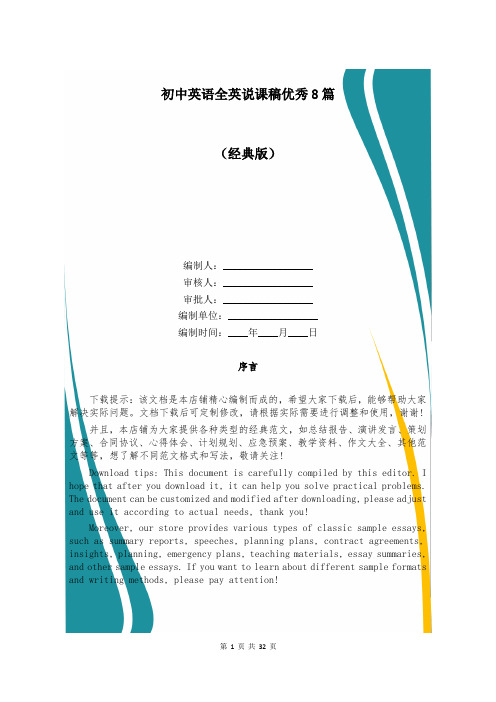
初中英语全英说课稿优秀8篇(经典版)编制人:__________________审核人:__________________审批人:__________________编制单位:__________________编制时间:____年____月____日序言下载提示:该文档是本店铺精心编制而成的,希望大家下载后,能够帮助大家解决实际问题。
文档下载后可定制修改,请根据实际需要进行调整和使用,谢谢!并且,本店铺为大家提供各种类型的经典范文,如总结报告、演讲发言、策划方案、合同协议、心得体会、计划规划、应急预案、教学资料、作文大全、其他范文等等,想了解不同范文格式和写法,敬请关注!Download tips: This document is carefully compiled by this editor. I hope that after you download it, it can help you solve practical problems. The document can be customized and modified after downloading, please adjust and use it according to actual needs, thank you!Moreover, our store provides various types of classic sample essays, such as summary reports, speeches, planning plans, contract agreements, insights, planning, emergency plans, teaching materials, essay summaries, and other sample essays. If you want to learn about different sample formats and writing methods, please pay attention!初中英语全英说课稿优秀8篇说课活动分课前说课和课后说课两种形式,不论是课前说课还是课后说课上述内容必须阐述清楚。
初中英语全英文说课稿模板

初中英语全英文说课稿模板make XXX.Third。
the nal objective:XXX reading and learning English。
and to XXX China and other countries.Part 2 The analysis of studentsThe target students of this lesson are Grade 8 students who have already learned basic English knowledge and skills。
They have a certain level of English n。
but still need to XXX。
Some students may be more interested in the topic。
while others may need XXX.Part 3 Teaching methodsIn this lesson。
I will use a n of us teaching methods。
such as task-based learning。
XXX。
and XXX ns。
debates。
and XXX their confidence in using English.Part 4 Teaching resI will start XXX related to the topic to arouse students' interest and XXX knowledge。
Then。
I will give a brief n to the article and explain some new words and phrases。
After that。
Iwill guide students to read the article and help them to understand the main idea and specific n。
初中英语说课稿英文版模板
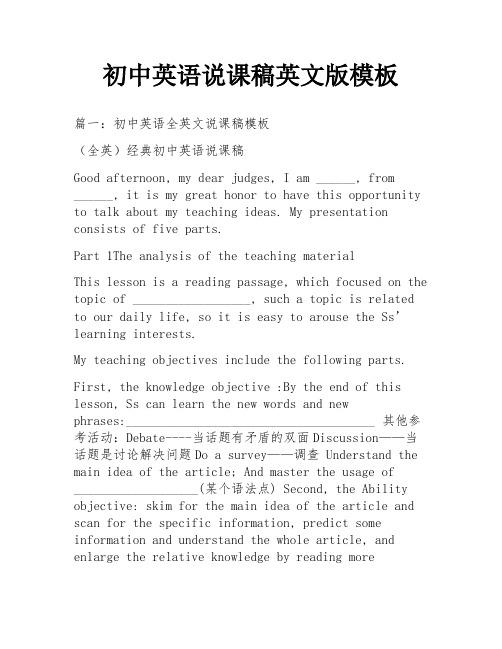
初中英语说课稿英文版模板篇一:初中英语全英文说课稿模板(全英)经典初中英语说课稿Good afternoon, my dear judges, I am ______, from______, it is my great honor to have this opportunity to talk about my teaching ideas. My presentation consists of five parts.Part 1The analysis of the teaching materialThis lesson is a reading passage, which focused on the topic of __________________, such a topic is related to our daily life, so it is easy to arouse the Ss’ learning interests.My teaching objectives include the following parts.First, the knowledge objective :By the end of this lesson, Ss can learn the new words and newphrases:______________________________________ 其他参考活动:Debate----当话题有矛盾的双面Discussion——当话题是讨论解决问题Do a survey——调查 Understand the main idea of the article; And master the usage of___________________(某个语法点) Second, the Ability objective: skim for the main idea of the article and scan for the specific information, predict some information and understand the whole article, and enlarge the relative knowledge by reading morematerials in library or from internet, write a report of the topic, etc.Third,the emotional objective: to develop the spirit of cooperation through teamwork and pair-discussion; arouse Ss’ interest in English learningForth, the Cultural awarenessFifth,the Important points: to get an overall understanding of the whole text, and develop their reading skills such as anticipating, skimming, scanning, summarizing language points…..…(具体课型用具体例子阐述) the usage ofthe______________________( 语法或句型)While the Difficult points:Are enable the Ss to use the new words and phrases to express their ideas in daily life, and develop the ability of skimming and scanning. master the usage of____________________________( 语法或句型)根据教学过程设计的内容来决定)Part 2 The analysis of studentsThe Ss have learned English for some years. They understand some words and simple sentences. They are curious, active, and fond of game, petition, and various activities. They enjoy learning through cooperation in a relaxing atmosphere.Part 3 Teaching methodsIn this lesson, My teaching methods includeaudio-visual teaching method, municative teaching method, and task-based teaching methods.Besides, a puter, blackboard, a tape recorder, a projector are needed as the teaching aids.Part 4 Teaching proceduresThere are five steps in my teaching procedures. But before teaching, I will divide the whole class into 4 groups to do petitions while finish different tasks in this lesson.Step 1 Warming-up and leading in (3mins)Free talk; talk something related the topic of the article.参考活动:Brainstorming, setting the scene, show pictures etc.Purpose: activate the Ss to regard the topic of___________________(主题) and create a relaxing atmosphere.Step 2 Pre-reading (10mins)There are 3 tasks for the Ss.(1)Do a guessing game.(2)Show some funny pictures and sentences on PPT and then ask the Ss to(3)Guess the meaning of the new words.Practice the new words and phrases:Match the new words and phrases with the Chinese meanings.Predicting: based on the title/ pictures on the text. ( 看具体情况而定)Purpose: through guessing, to arouse Ss learning interest, and help them to learn the new words and phrases which they may e across while reading, pave the way for the following learning and cultivate the ability of anticipating.{Meanwhile, pronunciation of some letter strings such as “ea” (pea, tea, feast..) and “er” (cucumber…) are highlighted so as to foster students’ phonetic sensitivity.} (如果有语音教学则可渗透。
初中说课稿模板英语全英文
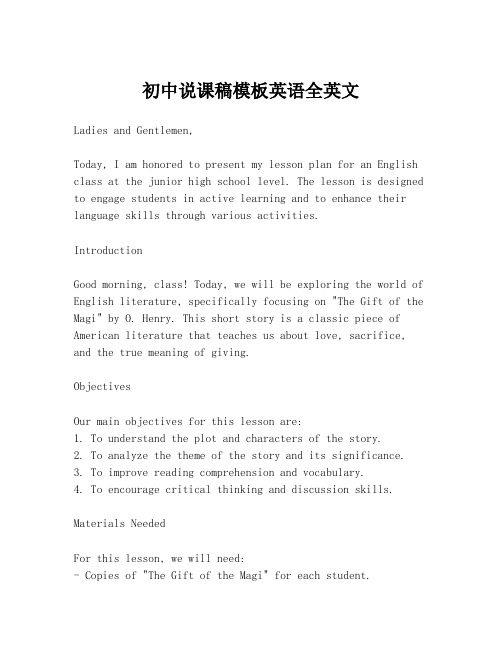
初中说课稿模板英语全英文Ladies and Gentlemen,Today, I am honored to present my lesson plan for an English class at the junior high school level. The lesson is designed to engage students in active learning and to enhance their language skills through various activities.IntroductionGood morning, class! Today, we will be exploring the world of English literature, specifically focusing on "The Gift of the Magi" by O. Henry. This short story is a classic piece of American literature that teaches us about love, sacrifice, and the true meaning of giving.ObjectivesOur main objectives for this lesson are:1. To understand the plot and characters of the story.2. To analyze the theme of the story and its significance.3. To improve reading comprehension and vocabulary.4. To encourage critical thinking and discussion skills.Materials NeededFor this lesson, we will need:- Copies of "The Gift of the Magi" for each student.- Whiteboard and markers.- Handouts with vocabulary words and comprehension questions. - A projector to display images or videos related to the story.Procedure1. Warm-up Activity (5 minutes): We will start with a quick vocabulary match game to review words related to the story. This will set the stage for our reading and discussion.2. Reading (20 minutes): Students will read the story silently, taking notes on the characters, plot, and any unfamiliar words.3. Vocabulary Review (10 minutes): After reading, we will review the vocabulary handout, ensuring that students understand the meaning of new words.4. Comprehension Check (10 minutes): We will go through the comprehension questions to ensure that students have grasped the main ideas of the story.5. Discussion (15 minutes): In pairs or small groups, students will discuss the theme of the story, the sacrifices made by the characters, and what they learned about the value of giving.6. Creative Writing (15 minutes): Students will write a short paragraph or a dialogue inspired by the story, focusing on a similar situation where they had to make a sacrifice forsomeone they cared about.7. Wrap-up (5 minutes): We will conclude the lesson by summarizing the key points discussed and reflecting on the importance of the story's message.AssessmentStudents will be assessed based on their participation in the discussion, the quality of their creative writing, and their understanding of the story's theme and vocabulary.ConclusionIn conclusion, this lesson aims to not only improve students' English language skills but also to impart valuable life lessons through the power of literature. I believe that by the end of this lesson, students will have a deeper appreciation for the story and its underlying message.Thank you for your attention, and I look forward to afruitful and engaging lesson.[End of Lesson Plan]。
新目标九年级全英说课稿
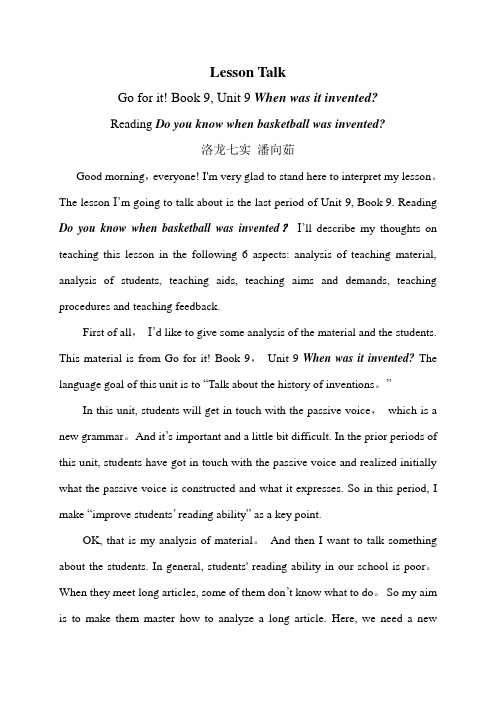
Lesson TalkGo for it! Book 9, Unit 9 When was it invented?Reading Do you know when basketball was invented?洛龙七实潘向茹Good morning,everyone! I'm very glad to stand here to interpret my lesson。
The lesson I’m going to talk about is the last period of Unit 9, Book 9. Reading Do you know when basketball was invented?I’ll describe my thoughts on teaching this lesson in the following 6 aspects: analysis of teaching material, analysis of students, teaching aids, teaching aims and demands, teaching procedures and teaching feedback.First of all,I’d like to give some analysis of the material and the students. This material is from Go for it! Book 9,Unit 9When was it invented?The language goal of this unit is to “Talk about the history of inventions。
”In this unit, students will get in touch with the passive voice,which is a new grammar。
英语说课稿新目标英语七年级下unit7全英文说课稿

Unit 7 What does he look like ? section A Good afternoon everyone ! I’m very glad to interpret my lesson here today.The lesson plan I'm going to talk about is from Book I Unit 7 What does he look like ?—the first period. The language goal is: Describe pe ople’s looks . and there are some new description words in it .My understanding of teaching materials include three parts :(1)the first one from 1a to 1c . In this part ,help students learn the new words and language .try to describe people with them .(2)the second part from 2a to 3 ,in this part mainly practice their listening and writing .(3) the last part is Grammar Focus , in this part I’ll ask students to sum what they have learned in class and Explain some important things to them●In this unit students learn to describe people . and the main content of thislesson are the sentences : What does he\she look like ?What do you\they look like? the answers and some description words.●The ability aim is to describe people’s looks .●As a new lesson I’ll use different kinds of methods to encourage the studentsto practice . Make them describe various people and be interested in my class .There are eight steps in the lesson . Here are the steps .Step I RevisionShow some pictures of people or other things to revise description words they have learnedLike :old \young \beautiful \ugly \cute \long and so on . Here are the pictures : Step II presentationFirst , I‘ll use some pictures to teach new words : Show some famous star’s photos to teach new words . such as Yao Ming . He is tall . He has short hair . Here I’ll introduce the new language : What does he look like ? He is _______ . He has ________ . and then let students ask and answer with the pictures, Then do 1a match the words with the pictures . finish1b, listen and fill in the blanks . Students read the conversation together .Step III pair work1c: In this part point out the sample conversation . and ask students to make a new conversation imitate it . look at the picture on page 41, they describe one of them,and other students find him or her . After this do Exercise 1 on paper .Step IV listeningIn this part we’ll finish 2a and 2b . This activity provides guided listening and writing practice using the target language .first listen and circle the correct word, either is or has, When they hear it in the conversation. and then point at the chart in 2b, listen and complete it . then finish Exercise 2Step V GameDescribe someone in the class . Ask your classmates to guess who he is describing then do Exercise II.Work in groups . and at last find which group has the most right answers and they are the champion . have a flag .Step VI Pair work and writingDescribe Lily’s new friend . complete the dialogue with words to describe Nancy’s looks . then write a new conversation imitate it Finish Exercise 3. Step VII Sum and TestReview the grammar box . Ask students to read the questions and answers . Point out some important things : I’m , they’re , he’s and she’s with description of he ight and build .Step VIII Homework .Write a short passage about your good friends ,mother , or father .I think using the target teaching method and the change of pictures and the competition may arise students interest . Each student can attend the teaching steps . and try to describe various people .improve their abilities .At last is my blackboard designment :What does he look like ? Words :He’s tall. Short hairHe has short hair . curly hair \medium build \thin\medium height That's all for my presentation. Thank you for your attention.Exercises :1.完成对话:A: Do you know my good friend Linda ?B: Linda ? What _____ she look ______ ?A: She’s ______ ______ (中等身材),she’s very ______ (瘦)。
初中英语全套说课稿模板

初中英语全套说课稿模板尊敬的各位评委、老师们:大家好!今天,我将为大家说课一节初中英语课。
本节课选自《新目标英语》八年级上册,Unit 6 I’m going to study computer science. 这是一节以职业规划和未来展望为主题的课程,旨在帮助学生了解不同职业,并激发他们对未来的规划意识。
一、教学目标1. 知识目标:学生能够掌握本单元的核心词汇,如scientist, engineer, programmer等,以及句型“I’m going to…”来表达未来计划。
2. 能力目标:通过听说读写的综合训练,提高学生的英语口语表达能力和理解能力。
3. 情感态度与价值观目标:引导学生认识到规划未来的重要性,激发他们对科技和未来职业的兴趣。
二、教学重点与难点1. 教学重点:掌握核心词汇和句型,能够用英语谈论自己的未来计划。
2. 教学难点:运用所学句型进行流畅的口语表达,以及理解并运用职业相关词汇。
三、教学准备1. 教师准备:多媒体课件、实物道具、录音设备等。
2. 学生准备:预习本单元词汇和句型,准备谈论自己的未来计划。
四、教学过程1. 导入(Warm-up):- 通过播放一段关于不同职业的视频,引起学生对职业规划的兴趣。
- 与学生进行简短的自由对话,询问他们的职业梦想。
2. 新课呈现(Presentation):- 利用图片和实物道具,教授本单元的核心词汇。
- 通过听力练习,让学生熟悉并理解句型“I’m going to…”的用法。
3. 操练(Practice):- 分组活动,让学生练习使用新词汇和句型描述自己的未来计划。
- 教师巡视指导,及时纠正发音和语法错误。
4. 巩固(Consolidation):- 组织角色扮演活动,让学生模拟不同职业人士,进行对话练习。
- 通过填空、连线等练习形式,巩固学生对词汇和句型的掌握。
5. 总结与作业(Summary and Homework):- 总结本节课所学内容,强调职业规划的重要性。
- 1、下载文档前请自行甄别文档内容的完整性,平台不提供额外的编辑、内容补充、找答案等附加服务。
- 2、"仅部分预览"的文档,不可在线预览部分如存在完整性等问题,可反馈申请退款(可完整预览的文档不适用该条件!)。
- 3、如文档侵犯您的权益,请联系客服反馈,我们会尽快为您处理(人工客服工作时间:9:00-18:30)。
(全英)经典初中英语说课稿Good afternoon, my dear judges, I am ———, from ————, it is my great honor to have this opportunity to talk about my teaching ideas. My presentation consists of five parts.Part 1 The analysis of the teaching materialThis lesson is a reading passage, which focused on the topic of __________________, such a topic is related to our daily life, so it is easy to arouse the Ss’ learning interests.My teaching objectives include the following parts.First, the knowledge objective :By the end of this lesson, Ss can learn the new words and new phrases:______________________________________ 其他参考活动:Debate----当话题有矛盾的双面Discussion——当话题是讨论解决问题Do a survey——调查Understand the main idea of the article;And master the usage of ___________________(某个语法点)Second, the Ability objective:skim for the main idea of the article andscan for the specific information,predict some information andunderstand the whole article, andenlarge the relative knowledge by reading more materials in library or from internet, write a report of the topic, etc.Third the emotional objective:to develop the spirit of cooperation through teamwork and pair-discussion;arouse Ss’ interest in English learningForth, the Cultural awarenessFifth the Important points:to get an overall understanding of the whole text,and develop their reading skills such as anticipating, skimming, scanning, summarizing language points…..…(具体课型用具体例子阐述)the usage of the______________________( 语法或句型)While the Difficult points:Are enable the Ss to use the new words and phrases to express their ideas in daily life, and develop the ability of skimming and scanning.master the usage of ____________________________( 语法或句型)根据教学过程设计的内容来决定)Part 2 The analysis of studentsThe Ss have learned English for some years. They understand some words and simple sentences. They are curious, active, and fond of game, competition, and various activities. They enjoy learning through cooperation in a relaxing atmosphere.Part 3 Teaching methodsIn this lesson, My teaching methods includeaudio-visual teaching method, communicative teaching method, and task-based teaching methods.Besides, a computer, blackboard, a tape recorder, a projector are needed as the teaching aids.Part 4 Teaching proceduresThere are five steps in my teaching procedures. But before teaching, I will divide the whole class into 4 groups to do competitions while finish different tasks in this lesson.Step 1 Warming-up and leading in (3mins)Free talk; talk something related the topic of the article.参考活动:Brainstorming, setting the scene, show pictures etc.Purpose: activate the Ss to regard the topic of ___________________(主题) and create a relaxing atmosphere.Step 2 Pre-reading (10mins)There are 3 tasks for the Ss.Do a guessing game.Show some funny pictures and sentences on PPT and then ask the Ss toGuess the meaning of the new words.Practice the new words and phrases:Match the new words and phrases with the Chinese meanings.Predicting: based on the title/ pictures on the text. ( 看具体情况而定)Purpose: through guessing, to arouse Ss learning interest, and help them to learn the new words and phrases which they may come across while reading, pave the way for the following learning and cultivate the ability of anticipating.{Meanwhile, pronunciation of some letter strings such as “ea” (pea, tea, feast..) and “er” (cucumber…) are highlighted so as to foster students’ phonetic sensitivity.} (如果有语音教学则可渗透。
)Step 3 While- reading (15mins)There are two tasks for the Ss.first reading:Ss read the article as quickly as they can and try to get the general idea by answer the following questions.Q1: who/ when/ what/ ……….second reading: pair-discussionSs read the article more carefully, and then discuss with their partners to finish the T/F exercises and fill in the table/blanks in the sentences.A : T/FB: Fill in blanks.根据课文内容而定。
参考活动:Fill in the table, make an outline of the article, find the topic sentences of each paragraph, etc.Purpose: the two tasks are aim to develop Ss’ reading ability. Skimming for the main idea of the article, and scanning for the specific information. And then get a deep understanding of the article.Step 4 Post-reading (10mins)1)Group discussion: fill in the blanksSs discuss the article with their group members, and find out the language points, such as the key words, phrases, and sentence structures in the article.And then fill in the blanks in a short passage present on the PPT. The short passage is made up from the article, and the answers are the language points in this lesson.After check the answers, I will help the Ss to summarize the language points.2)Retell:Use the key word and phrases presented on the PPT to retell the article.Make a report——小组合作,反馈Purpose: Through group work, cultivate the spirit of cooperation, and train the ability of solve problem by themselves. In class, the teacher is just a guide, while the Ss are the center, where, the teacher just join them, giving suggestions, and offering help when they need. Meanwhile, ask the Ss to retell the article, is an output, and it can evaluates how well the Ss learned in this lesson.Step 5 Homework (2mins)go over today’ lesson and preview the next lessongo to the library or search on the internet to get more extra material about this topic and then write a report.Purpose: consolidate the language points and do prepare for the next lesson, and develop the ability of writing.Part 5 LayoutTitleNew words new phrases 语法句子。
